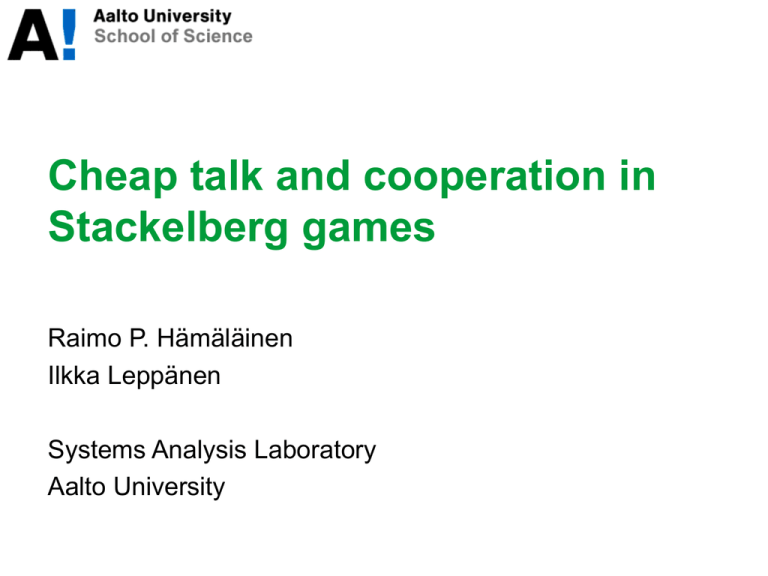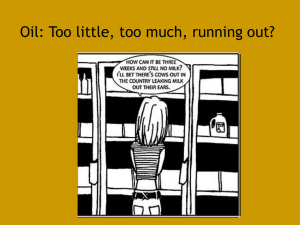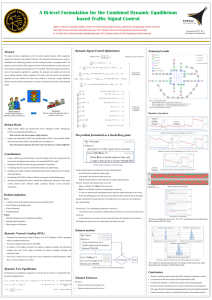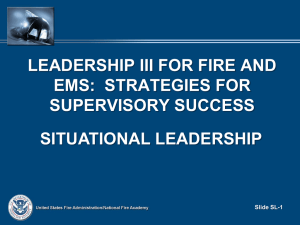Cheap talk
advertisement

Cheap talk and cooperation in Stackelberg games Raimo P. Hämäläinen Ilkka Leppänen Systems Analysis Laboratory Aalto University What drives cooperative behavior? • In one-shot interactions, other-regarding behavior can explain cooperation (Bowles and Gintis 2011) – For example, in the ultimatum game, people give fair offers • In repeated duopoly, players often collude to play the cooperative outcome (Normann 2006) – The motivation to collude may be either self-regarding or otherregarding • Cheap talk about intentions increases coordination when many equilibria are present (Crawford 1998) Cheap talk • Communication that does not directly affect payoffs (Farrell 1987, Crawford, 1998) • In the Stackelberg setting: when the leader has an opportunity to change his decision after the follower has decided, the leader’s first choice is cheap talk 3 Cheap talk in other settings • Cheap talk increases coordination on cooperation in a prisoner’s dilemma (Cooper et al. 1992) • Cheap talk price signaling in posted-offer laboratory markets increases price collusion (Cason 1995) • Verbal cheap talk communication in public goods games increases contributions (Cason and Khan 1999; Bochet, Page, and Putterman 2006) • Cheap talk between followers increases resistance to leader’s transgressions in the coordinated resistance game (Cason and Mui, forthcoming) 4 Cheating in the Stackelberg setting (Hämäläinen 1981) • Assumption: in a one-shot game the leader can change his decision after the follower’s decision and commitment • General cheating: the leader optimizes the initial announcement such that when the follower best responds to it the leader gets as close to his overall optimum as possible • Second-play cheating: the leader announces the Stackelberg leader decision and then re-optimizes after the follower has decided and committed 5 How to use cheap talk • If cheap talk is used for leader’s self interest: – The leader can try to use the general cheating strategy as a cheap talk announcement – If the follower believes that the leader commits to it and uses a best response then it provides the leader extra benefit • If cheap talk is used to signal cooperative intentions: – The leader can announce a joint-optimum outcome as cheap talk and commit to it if the follower responds by a joint-optimum decision 6 The Stackelberg duopoly • Two firms choose production quantities of a homogenous product to the market. One firm is the leader (a ”stronger” firm) and the other is the follower. • First, the leader commits to a production quantity by taking the follower’s best response into account • Then, the follower chooses a production quantity that is a best response to the leader’s quantity • In theory, the leader has a first mover advantage and the leader is better off than the follower 7 What is needed for the Stackelberg outcome • The leader needs to be committed to its decision • The follower does not need to know the payoffs of the leader to best respond 8 Experimental results on the Stackelberg duopoly • In one-shot interactions, Stackelberg outcomes are infrequent (Huck, Müller, Normann 2001) – Followers do not best respond but are inequity averse (Huck, Müller and Normann 2001, Lau and Leung 2010, Müller and Tan 2013) • In repeated interactions, cooperative joint-optimum outcomes emerge (Huck, Müller, Normann 2001) 9 Cheap talk in the Stackelberg setting If the follower ignores cheap talk: • The follower should take the role of the leader and decide by taking the leader’s best response into account • Then the outcome is the Stackelberg outcome where the follower is the leader and has the first mover advantage – The follower is better off than the leader If the follower does not ignore cheap talk: • He can best respond to it, cooperate if the cheap talk is cooperative, or even punish the leader 10 Our research questions • How does the leader’s cheap talk and the follower’s knowledge of the leader’s payoff information affect cooperation? – Does cooperation emerge in a repeated setting when the leader is not committed to his first announcement? – Does cooperation emerge in a repeated setting when the follower does not know the leader’s payoffs? 11 An experiment with four settings 1. The Stackelberg duopoly 2. Leader’s private payoff information in the Stackelberg duopoly 3. Cheap talk by the leader in the Stackelberg duopoly 4. Cheap talk by the leader and the leader’s private payoff information in the Stackelberg duopoly 12 The Stackelberg duopoly with leader’s private payoff information • Follower does not know leader’s payoffs – Represents e.g. a situation where the follower does not know the leader’s production costs, only its market payoffs • In theory the follower’s behavior should not change, because the follower does not need to know the leader’s payoffs in order to best respond 13 The Stackelberg duopoly with leader’s cheap talk • After the follower’s choice, the leader chooses again – Represents a situation where the leader is not committed to produce his first stage quantity • In theory the follower should ignore the leader’s cheap talk and take the role of the leader 14 Payoff matrix (same as in Huck, Müller, Normann 2001) JO = joint optimum L = Stackelberg equilibrium F = Stackelberg equilibrium when follower is leader LS = Follower best responds to cheap talk N = Cournot-Nash equilibrium Experiments (repeated interactions with fixed pairs) Rounds Number of pairs Stackelberg 24 11 Private info 22 14 Cheap talk 20 14 Cheap talk with private info 20 14 Setting • • • Total 106 subjects, engineering students Average monetary payoff 7.05 € Arranged in a computer classroom 16 Results Mean quantity Setting Mean payoff (standard dev.) Leader Follower Leader Stackelberg 7.83 8.23 52.9 (27.8) 57.9 Private info 9.35 8.23 52.2 (31.1) Cheap talk 8.05 7.73 58.4 Cheap talk with private info 7.74 7.29 64.1 17 Follower Median payoff Leader Follower (30.6) 61.5 72 45.7 (29.5) 64 55 (24.7) 55.1 (23.3) 72 64 (20.5) 59.61 (19.5) 72 65 Mean payoffs over time, Leader, Follower 2. Private info 70 70 60 60 mean payoff mean payoff 1. Stackelberg 50 50 40 40 30 30 1 2 3 4 5 6 7 8 9 10 11 12 13 14 15 16 17 18 19 20 round 1 2 3 4 5 6 70 70 60 60 50 40 30 30 2 3 4 5 6 7 8 9 10 11 12 13 14 15 16 17 18 19 20 round 50 40 1 8 4. Cheap talk with private info mean payoff mean payoff 3. Cheap talk 7 9 10 11 12 13 14 15 16 17 18 19 20 round 18 1 2 3 4 5 6 7 8 9 10 11 12 13 14 15 16 17 18 19 20 round Mean payoffs • Higher for followers in the Stackelberg setting, but higher for leaders in other settings • Total mean payoffs (leader+follower) are – highest in cheap talk with private information – lowest in private information – not significantly different between Stackelberg and cheap talk 19 Evolution of equal payoffs outcomes 1. Stackelberg 2. Private information 80 80 60 60 % 100 % 100 40 40 20 20 0 0 1 2 3 4 5 6 7 8 9 10 11 12 13 14 15 16 17 18 19 20 round 3. Cheap talk 1 2 3 4 5 6 7 8 9 10 11 12 13 14 15 16 17 18 19 20 round 4. Cheap talk with private info 80 80 60 60 % 100 % 100 40 40 20 20 0 0 1 2 3 4 5 6 7 8 9 10 11 12 13 14 15 16 17 18 19 20 round 1 2 3 4 5 6 7 8 9 10 11 12 13 14 15 16 17 18 19 20 round Grey shaded area: all outcomes with equal payoffs Blue: joint-optimum Red: Cournot-Nash 20 50 50 40 40 Frequency (%) Frequency (%) Outcomes in Stackelberg: cooperation 30 20 10 0 3 4 30 20 10 0 3 5 6 7 8 9 Follower 10 11 12 13 14 15 15 14 13 12 11 10 9 8 7 6 5 4 3 4 5 6 7 8 9 Follower Leader Rounds 1 - 5 10 11 12 13 14 15 15 14 13 12 11 10 9 Rounds 16 - 20 21 8 7 6 Leader 5 4 3 50 50 40 40 Frequency (%) Frequency (%) Outcomes in private info 30 20 10 0 3 4 30 20 10 0 3 5 6 7 8 9 Follower 10 11 12 13 14 15 15 14 13 12 11 10 9 8 7 6 5 4 3 4 5 6 7 8 9 Follower Leader Rounds 1 - 5 10 11 12 13 14 15 15 14 13 12 11 10 9 Rounds 16 - 20 22 8 7 6 Leader 5 4 3 50 50 40 40 Frequency (%) Frequency (%) Outcomes in cheap talk: cooperation 30 20 10 0 3 4 30 20 10 0 3 5 6 7 8 9 Follower 10 11 12 13 14 15 15 14 13 12 11 10 9 8 7 6 5 4 3 4 5 6 7 8 9 Follower Leader Rounds 1 - 5 10 11 12 13 14 15 15 14 13 12 11 10 9 Rounds 16 - 20 23 8 7 6 Leader 5 4 3 50 50 40 40 Frequency (%) Frequency (%) Outcomes in cheap talk with private information: cooperation 30 20 10 0 3 4 30 20 10 0 3 5 6 7 8 9 Follower 10 11 12 13 14 15 15 14 13 12 11 10 9 8 7 6 5 4 3 4 5 6 7 8 9 Follower Leader Rounds 1 - 5 10 11 12 13 14 15 15 14 13 12 11 10 9 Rounds 16 - 20 24 8 7 6 Leader 5 4 3 Responses to cheap talk • Mean cheap talk quantity is higher (8.59) in cheap talk with private information than in cheap talk (7.14) • Only 9% of followers react to cheap talk by best responses in the cheap talk setting – In Cheap talk with private info setting, 24 % of followers best respond to cheap talk • When the leader’s cheap talk announcement is the jointoptimum quantity, 35% of followers respond with the joint-optimum quantity – In Cheap talk with private info, this figure is similar at 34 % 25 Cheap talk and cooperative outcomes • 33% of all outcomes are cooperative joint-optimum outcomes – In these outcomes, 96% of the leaders commit to their initial announcement of the joint-optimum choice – Conclusion: the joint-optimum is not reached by cheap talk and a change in the second stage decision of the leader, but by commitment to initial joint-optimum play • With private info, 35% of all outcomes are cooperative joint-optimum outcomes – 95% of the leaders commit to their initial joint-optimum announcement if the outcome is a joint-optimum 26 Cheap talk and non-cooperative outcomes • In non-cooperative outcomes, only 17% of leaders commit to their cheap talk • In Cheap talk with private info, commitment rate is 21% when the outcome is not the cooperative joint-optimum outcome 27 Comparison: one-shot interactions in the random matching experiment • There are only a few Stackelberg outcomes • There are no joint-optimum outcomes • Payoff differences between leaders and followers are smaller than in the Stackelberg outcome, indicating inequity aversion • Most frequent outcome is the Cournot-Nash outcome 28 In cooperation leaders commit to initial announcement (cheap talk) • Higher share of cooperation than in Stackelberg – 57 % of outcomes at the last round, and 33 % of all outcomes in all rounds, are joint-optimum outcomes (vs. 45% and 22% in Stackelberg) – Followers do not take the role of leaders even if they could • Leaders get better mean and median payoffs than followers • In pairs who cooperate, leaders announce the jointoptimum choice and commit to it 29 What drives cooperation in Stackelberg settings? • Full information about leader’s payoffs – Gives the follower a possibility to evaluate trustfulness of the leader • Commitment to cheap talk – Cheap talk is not used for self-regarding outcomes – The joint-optimum is not reached by cheap talk and a change in the second stage decision of the leader, but by commitment to initial joint-optimum play • Inequity aversion? 30 Literature • Bochet, O., Page, T., and Putterman, L. 2006. Communication and Punishment in Voluntary Contribution Experiments, Journal of Economic Behavior and Organization, Vol. 60, No. 1. • Bowles, S. and Gintis, H. 2011. A Cooperative Species. Human Reciprocity and its Evolution, Princeton, NJ: Princeton University Press. • Cason, T.N. 1995. Cheap Talk Price Signaling in Laboratory Markets. Information Economics and Policy, Vol. 7. • Cason, T.N., and Khan, F.U. 1999. A Laboratory Study of Voluntary Public Goods Provision With Imperfect Monitoring and Communication. Journal of Development Economics, Vol. 58, No. 2. • Cason, T.N., and Mui, V-L. Coordinating Resistance Through Communication and Repeated Interaction. Forthcoming in The Economic Journal. • Cooper, R., DeJong, D.V., Forsythe, R., and Ross, T.W., 1992. Communication in Coordination Games. The Quarterly Journal of Economics, Vol. 107, No. 2, pp. 739 – 771. • Crawford, V.P., 1998. A Survey of Experiments on Communication via Cheap Talk. Journal of Economic Theory, Vol. 78, No. 2, pp. 286 – 298. • Hämäläinen, R.P. 1981. On the Cheating Problem in Stackelberg Games, International Journal of Systems Sciences, Vol. 12, No. 6, pp. 753–770. 31 Literature • Farrell, J., 1987. Cheap Talk, Coordination, and Entry. The RAND Journal of Economics, Vol. 18, No. 1, pp. 34 – 39. • Huck, S., Müller, W., and Normann, H-T., 2001. Stackelberg Beats Cournot: On Collusion and Efficiency in Experimental Markets. The Economic Journal, Vol. 111, No. 474, pp. 749 – 765. • Huck, S., and Wallace, B. 2002. Reciprocal strategies and aspiration levels in a CournotStackelberg experiment. Economics Bulleting, Vol. 3, No. 3, pp. 1 – 7. • Lau, S-H.P., and Leung, F., 2010. Estimating a Parsimonious Model of Inequality Aversion in Stackelberg Duopoly Experiments, Oxford Bulletin of Economics and Statistics, Vol. 72, No. 5, pp. 669 – 686. • Müller, W., and Tan, F., 2013. Who acts more like a game theorist? Group and individual play in a sequential market game and the effect of the time horizon. Games and Economic Behavior, Vol. 82, pp. 658 – 674. • Normann, H-T. 2006. Experimental Economics for Antitrust Law and Policy. SSRN Working Paper. 32







